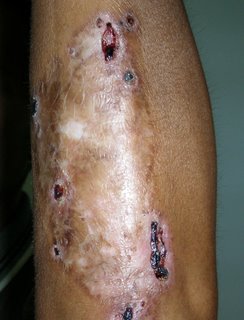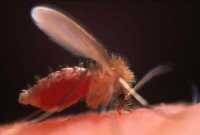
 While we are on the subject of neglected diseases, I am happy to report that I saw my first case of leishmaniasis last week. It was only cutaneous leishmaniasis, but I was excited nonetheless. My patient lives in El Petén, the Northernmost Department in Guatemala. Most of Petén is undeveloped jungle, filled to the brim with sandflies anmosquitoesos and various other creepy-crawlies.
While we are on the subject of neglected diseases, I am happy to report that I saw my first case of leishmaniasis last week. It was only cutaneous leishmaniasis, but I was excited nonetheless. My patient lives in El Petén, the Northernmost Department in Guatemala. Most of Petén is undeveloped jungle, filled to the brim with sandflies anmosquitoesos and various other creepy-crawlies.Most of you probably have the > 20 leishmania subspecies memorized. I was a bit rusty. I gave myself the Leishmaniasis for Dummies refresher course, which I will summarize below:
Leishmaniasis is a protozoan parasite. Molecularly, the parasite lifecycle and pathogenesis is similar to T. cruzi, which causes Chagas Disease (see previous post). The Leishhmania parasite vector is the female Phlebotomus dubosci sandfly, which is shown above right, enjoying a blood meal from a human host (picture courtesy of Welcome TDR image bank). In exchange for the blood meal, the fly passes the parasite back to the host, where it enters Macrophages. Infected macrophages either plant themselves in the skin, or travel through the reticuloendothelial system to infect various organ systems. But this may be beyond the scope of Leishmaniasis For Dummies...
Some leishmania species give patients ugly skin rashes (callecutaneousus or mucocutaneous disease). Other species cause more generalized constitutional ailments (visceral leishmaniasis). Full blown visceral leishmaniasis (VL) is called Kala-Azar, which is one of the DNDI Neglected Diseases (see Chagas Disease below). Kala-Azar presents with fever and weight loss, as well as diarrhea, body swelling, neurologicalgic disease, and rashes of all colors and patterns. The incidence of visceral leishmaniasis is high in patients co-infected with HIV. A 2006 study published by the journal Clinical Infectious Diseases cited that 70% of symptomatic VL patients were coinfected with HIV.
There is much more to say about Leishmaniasis, but I will spare you the details. I refer interested parties to the UpToDate Monograph, CDC, and WHO websites. Also, while browsing the internet for a pic of the sandfly that carries the parasite, I stumbled across the WHO TDR website, a most useful resource. WHO TDR is short for "The Special Programme for Research and Training in Tropical Diseases (TDR)." According to it´s mission statement, TDR is "an independent global programme of scientific collaboration. Established in 1975 and co-sponsored by the United Nations Children's Fund (UNICEF), the United Nations Development Programme (UNDP), the World Bank and the World Health Organization (WHO), it aims to help coordinate, support and influence global efforts to combat a portfolio of major diseases of the poor and disadvantaged. " Cool, ¿no? The best part is Welcome trust´s image databank, which has over 13,000 images related to TDR target diseases.
1 comment:
pneumocystis is interesting! and you probably see some good bronchiectasis down there. Do they still have that TB prison in bellevue?
Post a Comment